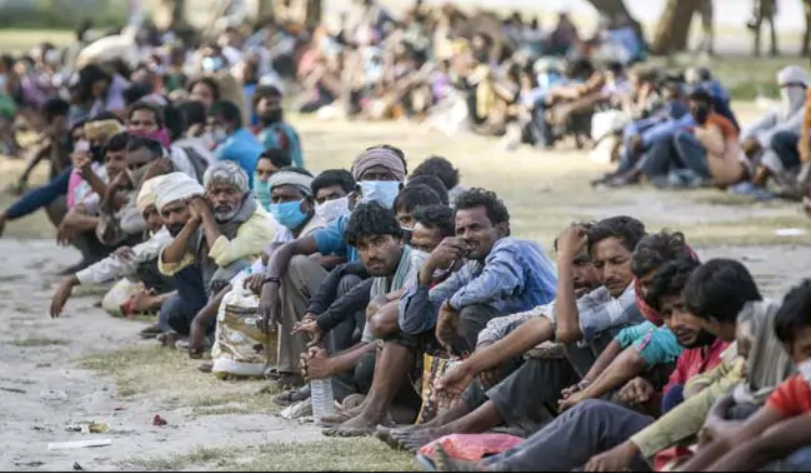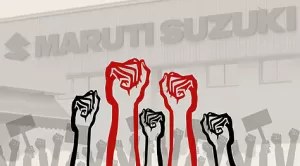Subodh Varma
On June 20, Prime Minister Modi announced that Rs 50,000 crore would be spent for giving jobs to returnee migrants by building durable rural infrastructure under the Garib Kalyan Rojgar Abhiyan (GKRA). He laced the announcement with fulsome praise of villagers who “effectively prevented coronavirus from spreading in rural India”, a claim that is far from the truth. But so it goes with most of Modi’s claims.
So, what is this GKRA? How is it going to address the daunting unemployment crisis in rural areas, aggravated by returnee migrants who fled cities following the countrywide lockdown that started on March 24 midnight and was eased only in June?
According to Modi, 25 work areas have been identified for employment in villages, like rural housing for the poor, plantation, provision of drinking water through Jal Jeevan mission, construction of panchayat bhavans, community toilets, rural mandis, rural roads, cattle sheds, anganwadi bhavans, etc. Most of these involve construction activity.
The Prime Minister also said that modern facilities, like high-speed and cheap internet, will be provided in rural areas. In other words, another activity will be the laying of optic fibre cables and related work is also a part of the Abhiyan.
Modi stressed that all these jobs can be done while staying in one’s village, without having to go to cities. This Abhiyaan will last for 125 days and will be implemented in 116 districts of six states, each with a large concentration of returnee migrant workers. These are: Bihar, Uttar Pradesh, Madhya Pradesh, Rajasthan, Jharkhand and Odisha.
There was also lofty talk about how each worker’s skill will be ‘mapped’ and jobs suitable to his/her skills will be given. At this point, the whole idea begins to stumble and one can’t help but feel that it is – as usual – going into la-la land. If most of the jobs going to made available are civil works, construction of this and that, then what’s the use of skill mapping and how will everybody’s skills be accommodated?
Repackaged Funding
If you start looking at the funding of this grand enterprise, the idea begins to sound even more jaded. As has been the practice of this government, there is NOT going to be any additional spending on its part for this programme. The Abhiyan will simply put together (“converge”) already existing schemes/programmes from 12 different Ministries/Departments, which include the Rural Development, Panchayati Raj, Road Transport & Highways, Mines, Drinking Water & Sanitation, Environment, Railways, Petroleum & Natural Gas, New & Renewable Energy, Border Roads, Telecom and Agriculture.
So, for instance, fibre optic cable laying for Bharat Net was already on the cards and funds were already allocated for it in this year’s Budget. This will now become part of GKRA. The same holds true for rural roads, anganwadi centres and panchayat bhavans and so on.
What has been adroitly done by the Modi government is that money already earmarked for these activities will be released to the 116 districts now itself. It’s a moot question as to how this will help create additional jobs – later also, the same work would be done by people, mostly local. Now, too, it will be done by the same number of local people. What is simply going to happen is that you push the unemployment crisis somewhat further down the road, by, say, two-three months. Nothing more, nothing less.
Bihar Assembly Elections is the Worry
Now, have a look at these 116 districts. It is reported that these have been selected on the basis of a cut-off of 25,000 returnee migrants. Any district with this many returnees at least is included for GKRA. Data in this regard is not available, but the strong protest voiced by the Chhattisgarh Chief Minister Bhupesh Baghel over his state not being included shows that some bias has operated in selecting the districts. Over five lakh migrants have reportedly returned to Chhattisgarh.
Then, there is the fact that 32 of Bihar’s 38 districts are included in the list. The programme was launched in Khagaria, one of the backward districts in Bihar. Clearly, Modi has another agenda in all this, and it is not difficult to see what that is.
The Bihar Assembly elections are supposed to be held in October this year. Home Minister Amit Shah has already held a virtual public rally in Bihar. Modi’s announcement and choice are no coincidence – it is the sounding of the poll bugle. That’s why the praise for villagers and their “valour” and “courage” in fighting the pandemic. That’s why the commiseration over the migrants’ plight and the assertion that this programme will help them the most.
Modi knows that the city-returned migrant workforce – numbering some 67 lakh, according to one report, of which some 23.6 lakh are from Bihar – will be singed with the trauma that they faced after being suddenly left without any job or earnings when the lockdown was announced. They further suffered immense hardships in trekking back to their villages. The Shramik trains to ferry them back were started only weeks later. Bihar has eight of the total 15 districts which saw over one lakh returnee migrants, according to another report.
So, in the coming electoral battle in Bihar, the odds were stacked against the Nitish Kumar-led government in which the Bharatiya Janata Party (BJP) is also participating. Remember that this government was formed by sabotaging the previous government of Nitish Kumar formed in alliance with the opposition Rashtriya Janata Dal, back in 2015. So the alliance of Nitish Kumar and BJP will face the electorate in a tough situation, not having earned many laurels in their term. The announcement of the GKRA is the sweetener – perhaps the first in a series, in the run-up to the elections.
That apart, the GKRA yet again displays the cage in which the present government has chosen to imprison itself. It doesn’t want to spend any money at all, for fear of displeasing global lenders and credit rating agencies. Its earlier programmes of relief and welfare – like the PM Garib Kalyan Yojana and the later Atma Nirbhar Bharat – could muster a mere 3% of GDP for actual spending from the government treasury, all the rest being credit lines. The present employment programme suffers from the same fate – and will likely fail for the same reasons.
(Subodh Varma is a senior Indian journalist.)




